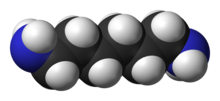Hexamethylenediamine

| |

| |
| Names | |
|---|---|
| Preferred IUPAC name
Hexane-1,6-diamine[3] | |
Other names
| |
| Identifiers | |
3D model (JSmol)
|
|
| 1098307 | |
| ChEBI | |
| ChEMBL | |
| ChemSpider | |
| DrugBank | |
| ECHA InfoCard | 100.004.255 |
| EC Number |
|
| 2578 | |
| MeSH | 1,6-diaminohexane |
PubChem CID
|
|
| RTECS number |
|
| UNII | |
| UN number | 2280 |
CompTox Dashboard (EPA)
|
|
| |
| |
| Properties | |
| C6H16N2 | |
| Molar mass | 116.208 g·mol−1 |
| Appearance | Colourless crystals |
| Density | 0.84 g/mL |
| Melting point | 39 to 42 °C (102 to 108 °F; 312 to 315 K) |
| Boiling point | 204.6 °C; 400.2 °F; 477.7 K |
| 490 g L−1 | |
| log P | 0.386 |
| Thermochemistry | |
Std enthalpy of
formation (ΔfH⦵298) |
−205 kJ mol−1 |
| Hazards | |
| GHS labelling: | |
 
| |
Signal word
|
Danger |
| H302, H312, H314, H335 | |
| P261, P280, P305+P351+P338, P310 | |
| NFPA 704 (fire diamond) | 
3
2
0 |
| Flash point | 80 °C (176 °F; 353 K) |
| Explosive limits | 0.7–6.3% |
| Lethal dose or concentration (LD, LC): | |
LD50 (median dose)
|
|
| Related compounds | |
Related alkanamines
|
|
Except where otherwise noted, data are given for materials in their standard state (at 25 °C [77 °F], 100 kPa). | |
| Infobox references | |
Hexamethylenediamine is the organic compound with the formula H2N(CH2)6NH2. The molecule is a diamine, consisting of a hexamethylene hydrocarbon chain terminated with amine functional groups. The colorless solid (yellowish for some commercial samples) has a strong amine odor. About 1 billion kilograms are produced annually.[4]
Synthesis[]
Hexamethylenediamine was first reported by Theodor Curtius.[5] It is produced by the hydrogenation of adiponitrile:
- NC(CH2)4CN + 4 H2 → H2N(CH2)6NH2
The hydrogenation is conducted on molten adiponitrile diluted with ammonia,[6] typical catalysts being based on cobalt and iron. The yield is good, but commercially significant side products are generated by virtue of reactivity of partially hydrogenated intermediates. These other products include 1,2-diaminocyclohexane, hexamethyleneimine, and the triamine bis(hexamethylenetriamine).
An alternative process uses Raney nickel as the catalyst and adiponitrile that is diluted with hexamethylenediamine itself (as the solvent). This process operates without ammonia and at lower pressure and temperature.[4]
Applications[]
Hexamethylenediamine is used almost exclusively for the production of polymers, an application that takes advantage of its structure. It is difunctional in terms of the amine groups and tetra functional with respect to the amine hydrogens. The great majority of the diamine is consumed by the production of nylon 66 via condensation with adipic acid. Otherwise hexamethylene diisocyanate (HDI) is generated from this diamine by phosgenation as a monomer feedstock in the production of polyurethane. The diamine also serves as a cross-linking agent in epoxy resins.
Safety[]
Hexamethylenediamine is moderately toxic, with LD50 of 792–1127 mg/kg.[4][7] Nonetheless, like other basic amines, it can cause serious burns and severe irritation. Such injuries were observed in the accident at the BASF site in Seal Sands, near Billingham (UK) on 4 January 2007 in which 37 persons were injured, one of them seriously.[8][9]
Stability[]
Hexamethylenediamine is stable in air but combustible. It is incompatible with strong oxidants.
References[]
- ^ Merck Index, 11th Edition, 4614.
- ^ MSDS
- ^ "1,6-diaminohexane - Compound Summary". PubChem Compound. USA: National Center for Biotechnology Information. 26 March 2005. Identification and Related Records. Retrieved 29 May 2012.
- ^ a b c Robert A. Smiley "Hexamethylenediamine" in Ullmann's Encyclopedia of Industrial Chemistry, Wiley-VCH, Weinheim, 2005. doi:10.1002/14356007.a12_629
- ^ Curtius, Theodor and Clemm, Hans (1900) "Synthese des 1,3-Diaminopropans und 1,6-Diaminohexans aus Glutarsäure resp. Korksäure" (Synthesis of 1,3-diaminopropane and 1,6-diaminohexane from glutaric acid and suberic acid, respectively), Journal für praktische Chemie, 2nd series, 62 : 189–211.
- ^ "SRIC Report - Report 31C - Advances in Adiponitrile (ADN) and Hexamethylenediamine (HMDA) Processes | IHS Markit". ihsmarkit.com. Retrieved 2019-02-19.
- ^ "MSDS - H11696". www.sigmaaldrich.com. Retrieved 2019-02-19.
- ^ BBC News
- ^ BBC News
- Monomers
- Diamines